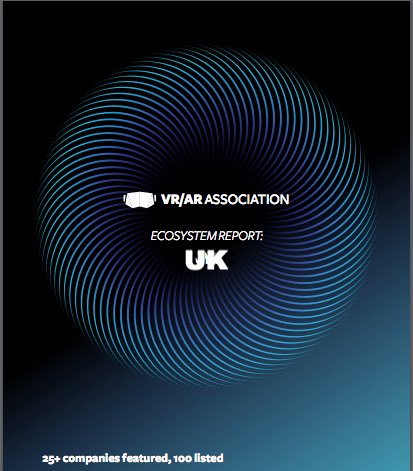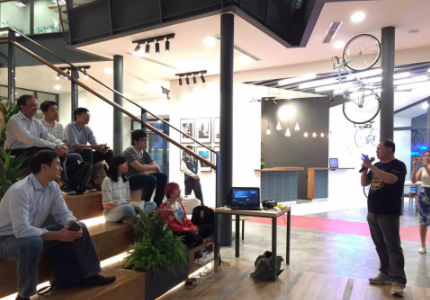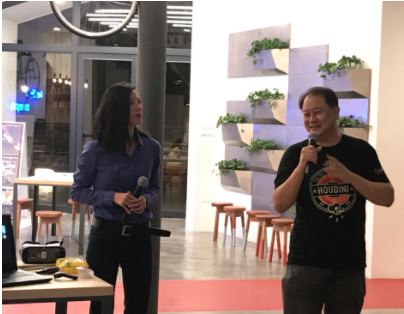Vanessa Radd, currently flies between Singapore, Shanghai and California, brings +15 years of experience in broadcast (TV Everywhere and LiveTV solutions), tech and VR/AR. Currently, Vanessa is President of the global VR/AR Association Singapore Chapter and heads partnerships in Asia for Holition, a UK-based augmented reality creative agency. Vanessa is ranked among the global Top 10 influencers in Augmented Reality. Vanessa is also the founder of the VR/AR Women in Asia Society and a member of The Media Alliance’ Board of Directors.
What projects are you working on at the moment? What does your current job role entail?
I wear several hats. I work on VR and AR consulting projects and represent several European/American brands in Asia. One of the companies that I represent is Holition, a London-based augmented reality experiential agency that provides immersive augmented reality experiences for luxury brands, entertainment and more. Holition creates beautiful experiences in augmented reality, as seen with the magic mirrors developed for Charlotte Tilbury’s Westfield store in London (which was mentioned in Forbes and New York Times as a retail trend to watch out for) and the virtual try-on makeup app for Coty’s Rimmel ‘Get The Look’ mobile app which won the DigiDay Europe Mobile App of the Year award. Holition also produced the largest augmented reality fashion show for Dunhill in Shanghai that was experienced ‘live’ by the audience present. At Holition, we believe in melding art and technology, to create beautiful experiences.
I’m also the president of the global VR AR Association (VRARA)’s chapter in Singapore. The role I take on is very industry development focused, and together with the members, and my global VRARA colleagues, we aim to promote a vibrant VR/AR ecosystem worldwide.
How long did it take you to be where you are now?
I have always taken a very independent, quintessential path in my career and in my entrepreneurial ventures.
I have a major in accounting, and a content creator’s mind in a career in media and technology. I’ve traversed from tech (software and hardware), to the broadcast and satellite industries, and now, VR and AR. I’m pretty much self-taught throughout my 15+ year career, and at every stage, I’ve taken what I’ve learned, and my skillsets and transitioned to a new product or platform.
In hindsight, perhaps there were early signs in my life of the sort of career path that I was going to get into -- the first website I had to build in one of my university courses was on satellites -- little did I know I would go into this field. It kind of seeked me out. I was also actively involved in the organizing of a regional robotics competitions in one of my earlier jobs, and have worked in helping close the broadcast-digital divide between developing and less developed countries through technology and education. Personally, I’ve always focused on using the right technology to help create content that benefits society-at-large and how it can bring diverse ideas together.
It is a natural progression for me and I feel very fulfilled in what I do in this new medium. In some way, I believe, VR/AR chose and embraced me as much as I’ve embraced it.
What was the biggest obstacle?
Broadcast technology, to many in the media circle, does not necessarily seem sexy as working in the content side of things. But I stuck at it as innovation is my passion. It’s an observation but not an obstacle.
What are the challenges of being an entrepreneur in the niche you are in? How about being a female entrepreneur?
As VR/AR is a nascent industry, people have varying expectations. In the greenfield work that I do, I find that I’m thrust into a position where I have to find the answers myself and educate the market about this new medium, and how it can be utilized. Companies are excited about VR and AR, however, to create beautiful experiences, there are specific instances that work, and some instances where VR and AR do not fit what they seek to do.
And because it’s something new, clients sometimes are not able to gauge and assess what a proper VR/AR creative agency is supposed to provide, and when traditional advertising agencies come into the picture and rebrand themselves as VR/AR companies, it may get even more convoluted. This is where, as president of VRARA’s Singapore Chapter, I’m able to help to set the guidelines on the industry standard for VR and AR to promote really good quality VR and AR work, for the benefit of the industry and a healthy ecosystem.
Secondly, pundits may come into the picture and want to invent new jargons. We need to circumvent this for the good of the industry.
As for being a female entrepreneur, there may be some few instances where men may ask questions that they might not ask men, even if you are a senior level executive, just to test you. In these instances, you know, you just take it with a smile and some humor. For me, this is all small stuff, don’t sweat it. I think women now, are already very much empowered in this day and age, and there are more opportunities than challenges.
Just hunker down and do the work. People will notice good quality work and strong leadership.
What are your biggest achievements to date?
Being part of a founding organizer-team of a digital-broadcast conference which is running now for over a decade. Growing the VR AR community in Singapore/Asia-Pacific as part of VRARA. Founding the VR/AR Women in Asia society. Being listed as global Top 3 Augmented Reality influencer by Onalytica.
What will be the key trends in the VR and AR in the next 5 years and where do you see it heading?
The intersection of AI, IOT and AR/VR will transform the way we work, communicate and collaborate.
More great VR arcade/theme park experiences.
We live in a 3D world, why not market brands and experience entertainment in 3D.
Conversations about security concerns in VR and AR.
Exploration of the open source platform in VR and AR.
This is the time to leap, and a very interesting time at that. My hope though, is that VR/AR will not effect a wider digital divide.
Is #WomenInTech and #WomeninVRAR movement important to you and if yes, why?
Personally, I haven’t really being conditioned to think so much about this but I do acknowledge that my gender does give me some opportunities, as well as barriers that come along with the package. It’s recognizing this and utilizing your strengths, being fearless, and taking action with grace.
As founder of VR/AR Women in Asia, I do actively seek out women at events and ask them to join the community. My personal mission is to raise the number of women developers in the field of VR and AR.
Diversity to me is important, and beyond the gender issue, it’s great if #WomenInTech and #WomeninVRAR can help open the doors to conversation on other diversity topics as well. Let us women support each other, and in addition, help to speak up for other groups.
What is the most important piece of advice you can give to all female founders and female entrepreneurs out there?
This has been said before, but I can’t stress enough the importance of true grit. On tough days when people may beat you down or doubt you, at the end of the day, you answer to yourself. Are you going to give up? Or are you going to get up and show up? Myself, being an aikido practitioner, it helps to know how to take falls well, and also getting up and rising for the next battle.
I’ll add to this -- stay curious, maintain a beginner’s mind, and be humble.
Who are your inspirational women in VR and AR industries?
Evelyn Miralles and the inspirational VRARA women.
Twitter: @vanradd
Linkedin: Vanessa Radd
Medium: Vanessa Radd



















